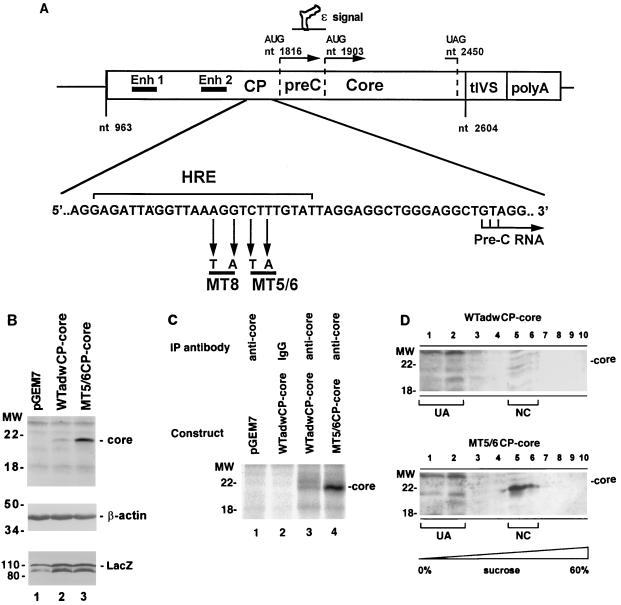FIG. 7.
Effect of MT5/6 on core expression is independent of HBV elements outside the core promoter and core gene. (A) Core expression constructs. The core expression constructs contain coding sequences for only core promoter and core protein. Enhancers I and II (Enh 1 and Enh 2), encapsidation signal (ɛ), and core promoter (CP) are illustrated above. tIVS, small t-antigen intron. The sequence of HBV adw strain in the core promoter region is shown below; the hormone response element (HRE) (where various members of nuclear receptor superfamily bind), MT5/6, and MT8 are indicated. (B) Core protein expression. adwCP-core or MT5/6CP-core constructs were cotransfected with a LacZ expression construct (pCDLacZ) as a transfection control into HuH-7 cells. Three days after transfection, cells were lysed and core expression was analyzed by immunoblotting (upper panel). To demonstrate similar protein loading and transfection efficiency in the experiment, the blot was stripped and reprobed with antiactin and anti-LacZ antibodies, respectively (middle and lower panels). In panels B to D, positions of molecular weight (MW) markers (in kilodaltons) are indicated on the left. (C) Core protein synthesis. After labeling of cellular and viral proteins with [35S]methionine and -cysteine for 15 min, HuH-7 cells were lysed and subjected to immunoprecipitation (IP) with a core-specific antibody (anti-core) or nonimmune serum (IgG). Immunoprecipitated proteins were analyzed by SDS-PAGE and autoradiography. (D) Nucleocapsid assembly. Lysates of transfected HuH-7 cells were subjected to sucrose velocity centrifugation (10 to 60% step gradient); 10 fractions were collected from the top and analyzed for core protein by immunoblotting with an anticore antibody. Nucleocapsid-associated core (NC) sedimented to fractions 5 and 6, whereas unassembled core monomers and dimers (UA) did not sediment and remained in fractions 1 and 2.

